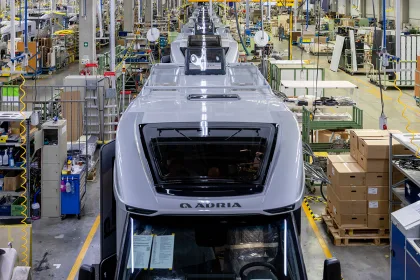Steve Haskew, Head of Sustainability and Social Leadership at Circular Computing, explains why addressing greenwashing and greenhushing needs to be a top priority for every CEO.
In an age of increased environmental and sustainability pressures, businesses of all sizes are facing pressure to illustrate their green credentials. Some choose to be overt, advertising sustainability and net zero claims front and centre in their communications, while others are choosing to say nothing at all and sit back hoping it doesn’t get brought up. Yet, neither approach is likely to be the best course of action for most businesses and has led to increased policy and economic issues with greenwashing and greenhushing.
The two terms, perhaps seen as sustainability buzzwords of our era, do in fact roughly summarise where many CEOs sit on sustainability – either letting marketing teams run wild with sustainability claims, or trying to hide a dodgy underbelly from the outside world. The reality is that the well-intentioned claims of sustainability and faux efforts to become more sustainable seen in greenwashing often fall short of the mark, and can even be equally as dangerous as doing nothing at all.
Simply put, our planet is now at a point where the term ‘green’ cannot be ‘washed’ or ‘hushed’ anymore; it needs to be rooted at the centre of all business decisions and operations. To make a real difference, prioritising the growth of the circular economy will help businesses understand how to achieve true sustainability and move beyond the smoke and mirrors tactics we see used by many today.
WHY GREENWASHING AND GREENHUSHING ARE DANGEROUS
With eco-conscious consumers anxious to support businesses that are protecting the planet, many have turned to illusion to win over their customers. Greenwashing happens when a company makes an environmental claim unsupported by data-driven evidence. Though the claim may have some element of truth regarding the positive effect on the environment, it likely fails to consider the true impact on the planet, and with potentially increased sales, may even do more damage than another more unsustainable product. A 2021 European Commission report found that 42 percent of green claims made by organisations were deceptive or exaggerated in some way, highlighting that this is becoming a commonplace tactic amongst many businesses. Even more recently, a report found that half of green claims used to sell products in the EU were misleading, according to the European Commission. This means oblivious consumers basing their purchase decisions on something they are told is environmentally friendly, may actually be damaging the planet more than they realise.
But as we see a crackdown on companies overly exaggerating their sustainability claims, seen in new EU anti-greenwashing legislation, there is another seriously concerning strategy in greenhushing. With businesses under fire over the credentials of their sustainability claims, many have chosen to try and fly under the radar. Companies from industries such as tech, finance, and the engineering sectors are often choosing not to provide updates on their environmental and climate action. A report published by South Pole found that nearly one in four of the 1,200 large private companies from 12 countries that have set net zero targets are yet to publicise their progress. Given the government targets in the UK such as reaching net zero greenhouse gas emissions in England and Wales by 2050, which could add two million years of life on Earth, far too many businesses are taking the easy route out on sustainability.
THE IMPORTANCE OF THE CEO TAKING NOTICE
For many business leaders preoccupied with the day-to-day running of their business, sustainability is likely something they feel is better suited to another member of the board. And while the rise of the Chief Sustainability Officer is a positive one, the need for the CEO to take on the responsibility of greening their business is more important than ever. Often, sustainability is left to the marketing team to communicate, which in order to come across better, can lead to exaggeration. The International Consumer Protection Enforcement Network analysed hundreds of websites for green claims versus the action being taken, and found that as many as 40 percent of environmentally friendly claims might be misleading customers. As a result, by leaving sustainability to other departments, CEOs are letting their brands create a false reality that they are sustainable without addressing it operationally. There are areas where the CEO can get involved in sustainable decisions today. Reviewing procurement strategies and ensuring to work with truly sustainable suppliers is a quick win that many CEOs can start actioning right away. We see in the technology industry that CEOs are often unaware of the hardware their employees use and are unlikely to be involved in the purchasing process. Yet, when the industry has evolved to the point that second-life remanufactured laptops are certified to perform as good as or better than new, with a financial saving and at no extra cost to the environment, it seems remiss of them to not be involved in making those decisions.
The rise in greenwashing and greenhushing could mean solutions like remanufacturing aren’t used or explored to their full potential. The circular economy has direct benefits to a business’ bottom line, to its genuine sustainability credentials, and to consumers and employees. Without embracing it, CEOs are at risk of adding to a false eco-reality, delaying progress and solutions to the problems at hand.
HOW YOU CAN COMMUNICATE YOUR SUSTAINABLE CREDIENTIALS
Leading sustainability from the top is key, never more so than when communicating it to the outside world. If the CEO can’t be trusted to discuss their business’ claims or actions, then why should anyone listen to the sales teams? With 65 percent of UK consumers thinking about the environmental impact of the items they buy and one-fifth of UK workers reporting they would turn down jobs based on poor ESG commitments, making sure people understand your sustainability strategy is essential.
For many business leaders, being honest and transparent about their sustainability progress is daunting, but there are ways to ensure you’re walking the walk as well as talking the talk. Using science-based targets, such as those set out by the Science Based Targets Initiative (SBTI), will ensure robust evidence to help you avoid misleading customers and unknowingly harming the planet. As mentioned earlier, ensuring your suppliers follow these targets too is an easy way of staying across the environmental impact of your business. For example, we’ve made sure to calculate with the SBTI that for every Circular Computing remanufactured laptop, approximately 316 kilogrammes (700lb) of CO2 emissions are prevented by not buying new. For just 1,000 laptops, that is the same as taking 80 cars off the road for a year.
Achieving true sustainability means business leaders leading by example, and ensuring the CEO is involved in addressing greenwashing and greenhushing will go a long way to eradicating bad practice from within the business.
































